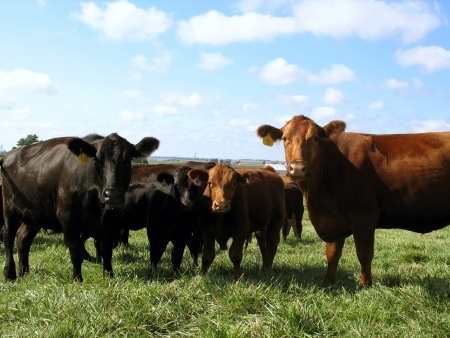 Flying H Genetics breeds five different types of cattle, using genetically enhanced expected progeny differences, or EPDs, and multitrait DNA analysis to ensure the animals you purchase are the exact breed for your needs. Today, let’s look at a few more of our most popular breeds – Angus, its close relative, Red Angus, and the crossbred SimAngus.
Flying H Genetics breeds five different types of cattle, using genetically enhanced expected progeny differences, or EPDs, and multitrait DNA analysis to ensure the animals you purchase are the exact breed for your needs. Today, let’s look at a few more of our most popular breeds – Angus, its close relative, Red Angus, and the crossbred SimAngus.
Angus
Angus cows have been incredibly popular since their introduction to the United States in 1873 for their ability to introduce functionality into herds while cutting operating costs and boosting profits. The animal is believed to have superior genetics, which leads to a high demand and premium value at market. Perhaps most importantly, the breed routinely satisfies producer and consumer needs thanks to its overall versatility and meat quality.
This exception lineage comes – in part – from the ability to track Angus cows through the beef supply chain. The American Angus Association has provided ranchers with innovative tools and resources, along with extensive herd records and registry data that allows for optimal breeding practices. When buyers know the history and lineage of their animals, they know the results will be more consistent leading to better results in the long term.
Red Angus
The Red Angus features many of the genetic benefits of the standard Angus, although there are some slight differences worth mentioning. Historically, Reds were traditionally viewed as less desirable for most of the 20th century, which means the number of records in their data base is not as extensive as that of Angus. Reds, though, are the most populous color of cattle worldwide.
Reds also have the advantage of tolerating heat much better than standard Angus cattle, making them a superior choice for hotter and more humid climates. The Red Angus also is endowed with a superior resistance to cancer eye and sunburned udders. With the majority of the world’s cattle found in warmer climates, the heat and sun tolerances of the Red Angus provide a definite advantage.
Finally, Reds also breed true, meaning they do not carry any diluter genes. This also means that Red Angus cattle typically avoid the gray cattle offspring that is more common when crossbreeding with standard Angus stock.
SimAngus
Flying H Genetics also breeds Angus cows with Simmental cows to create another hybrid breed called SimAngus. These two types of cows have complimentary genetics, including an ideal balance of maternal and carcass traits, leading to larger profitability for farms. SimAngus animals have a defined breeding process, and refers to animals that are at least a quarter Simmental and a quarter Angus or Red Angus, with the resulting offspring not having more than three-quarters of either breed. SimAngus cattle also cannot contain more than a quarter of its genetics from another breed outside the two.
With these animals, both parents must be registered in the American Simmental Association’s database to ensure that their lineage fits what producers are looking for. SimAngus cattle offer a great livestock breed that captures both heterosis and value, helping improve your bottom line.
Be sure to check back to the blog next week when we take a look at our final species of cattle – Fusions! For questions on our Angus breeds – or any of our other seed stock – call us today at 308-962-6500.



